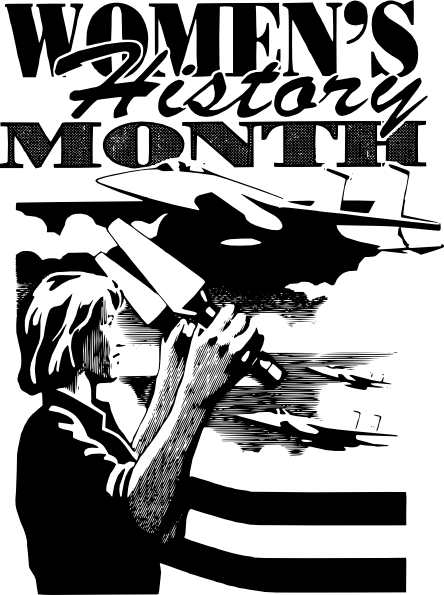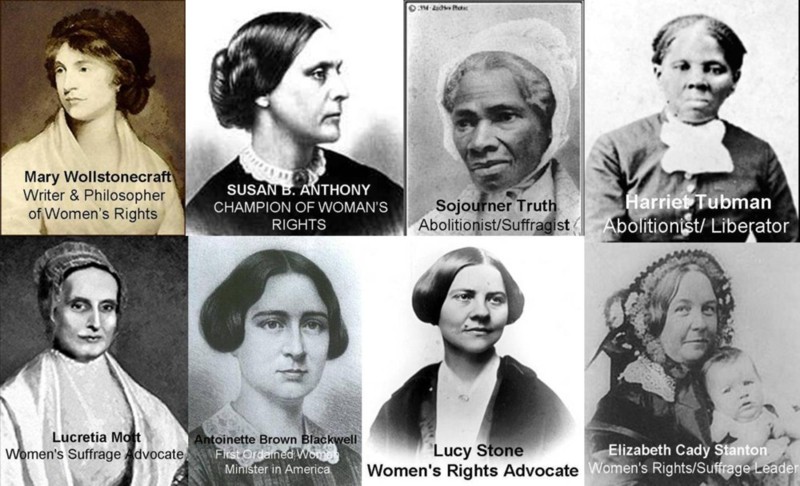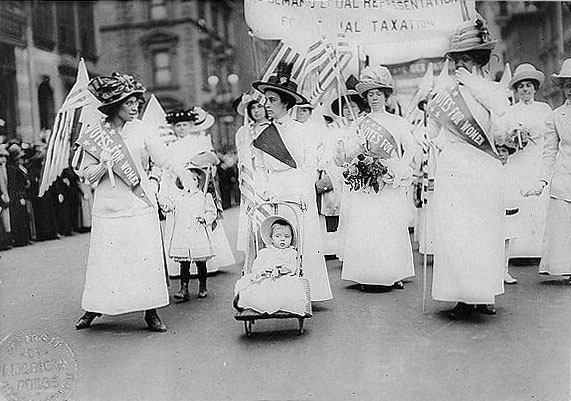Okay, so I am a little late to the party. It is already March 11th, and I am just getting around to my own reflections on National Women’s History Month (NWHM). I even missed International Women’s Day, but I think President Obama had it covered. (Historiann, the better blogger, already commented on the sausage fest that is the National Endowment Humanities Medal winners.) Timely, I am not.
The theme for NWHM this year is “Our History is Our Strength.” As a historian and as a woman (I wonder why I feel the need to say both?), this theme resonates and irritates. History, we know, functions as a legitimator to claims about men and women in our public culture as well as scholarly cultures See Bonnie Smith’s The Gender of History: Men, Women and Historical Practice (1998) for a rousing discussion of how history as praxis is gendered. Moreover, the reclamation of women in history, the analysis of the fluidity of gender in different historical spaces and places, and the ability to analyze how gender functions as code for power relations are all crucial to understanding not only the place of women in American culture but also the constructions of womanhood/manhood and the consequences of these constructions. History becomes a possible tool of empowerment and agency because of its weight, its veracity, and its power to present our pasts to us.

Women’s history month as a concept bothers me, though. Much like the critiques of Black History Month as separate space/history, I fear the limiting scope of one month as women’s month. The tagline in my head proclaims, “Women’s History, just a month every year!” My criticism is not original or new, but the concept of one month as the stand-in for the whole of women’s history is problematic. And it encourages the popular belief about history as “his-story,” a tired joke that still matters. One month a year cannot possibly d0 justice to the lives of American women and women globally, but I will take one month if the other possibility is no inscription of women’s history on our calendar year. I want celebrations of women’s history as history, unavoidable and required, rather temporary, demarcated and different. Women’s history is American history, and it is clearly American religious history.
Recently, I find myself describing my work as not just American religious history but also gender history. The mantle of gender historian is not new for me, but there is a new stridency. Yet, I find myself reading recent historical works and asking, “Where’s gender? Where are women in religious institutions, movements and practice? Why don’t we discuss masculinity more?” When I feel really sassy, I ponder, “How can one do work in the twenty-first century without at least gesturing to gender?” I am not asking for much, an awareness of the social constellation attached to sexed bodies would be a good start. Perhaps, a glance at Judith Butler’s Gender Trouble or Bodies That Matter, an occasional use of Michel Foucault on power, or hell, a nice lengthy description of how men and women in a variety of religious movements practice, believe, embody or “live” religion in relation to their gender. Gesturing to gender is better than ignoring the centrality of social and religious value attached to sexed bodies. Religious folk are not just what they believe or do. They have bodies. Bodies matter. Sexed bodies matter.

My teaching has forced this issue, like so many others. There is new pressing urgency to the import, and likely centrality, of gender to religious studies. Since I am teaching a gender and religion course, I feel like my whole semester is a women’s history celebration while simultaneously a desperate mission to emphasize the centrality of women’s history and gender history to religious history. Much like Catherine Brekus in her introduction to The Religious History of American Women, I wonder why American religious history still seems impenetrable to women’s history, gender theory, and my current pet peeve, discussions of masculinity and men constructed as men. Gender matters, but convincing one’s peers can be a zero-sum game. (To see my take on the problem of women and leadership, click here.) Why, I wonder, is it possible to ignore Ann Braude‘s salient and punchy statement, “Women’s history is American religious history”? She’s right. Almost fifteen years after her essay appeared in Retelling U.S. Religious History (1997), what gives? Braude eloquently showcases the sheer presence of women in American religious spaces. Women were the “people in the pews” for the majority of American history. By dismantling the popular thesis of feminization, Braude showcases that women did not “feminize” churches because their presence was the constant, not the presence of men. Braude’s insight should be foundational to explorations of American religious life alongside critical theories of race, class, and market. Perhaps, my stridency rears its ugly head here or not. What I want, if I could convince the historiographies of American religious history to bend to my will, is honest engagement of the impact of gender on the religiosity of American men and women as well as increasing attention to fluidity of gender identity in the historical past and the contemporary period.

Moreover, I want to pass out Joan Wallach Scott‘s famous essay, “Gender: A Useful Category of Historical Analysis” (1986) to anyone who doesn’t attempt to describe and analyze (or please theorize) gender. Scott’s masterful article articulates how gender had evolved as an analytical tool from studies of women to an idea that the study of women was the study of men to how gender was viewed as a cultural construction. For Scott, descriptive analysis was not sufficient to affect historical paradigms. Descriptive analysis cannot cut it, so Scott critiqued previous models that centered on origins of patriarchy, which relied on physical differences between men and women and perpetuated essentialism, Marxian analyses, which explained gender as only the by-product of changing economic structures, and the prevalence of psychoanalysis, which was influenced by French post-structuralists and object relations theory. Scott called for a historicization and deconstruction of the binary opposition of gender rather than relying upon an assumption that exists. Scott proposed a new definition of gender, which was an element of social relationships based on perceived sex differences as well as a “primary” way of articulating power relationships. Thus, Scott threw down the gauntlet rather than assume gender in our analyses, we must question the opposition between male and female and to see what is at stake when gender is used to legitimate a position. What Scott is proposing is to see how gender is constructed and how it is deployed. She urges historians to examine what happens when someone invokes gendered language. What’s at stake? What’s gained by invoking gender? The better question might be: What is at stake in avoidance?
Thus, to celebrate women’s history, I will be posting blurbs about my favorite women’s and gender historians in American religious history for the rest of March. Please feel free to send your suggestions to me. [Cross-posted at usreligion.blogspot.com]